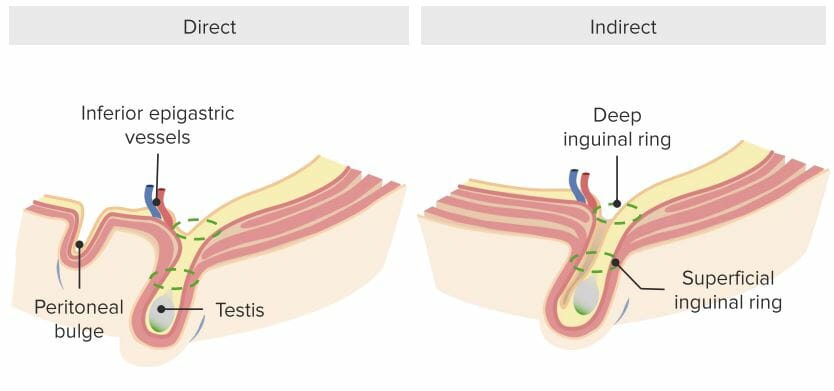Playlist
Show Playlist
Hide Playlist
Patient Introduction and Review of Anatomy of the Male Genitourinary System
-
Slides Physical Exam Male Genital Introduction.pdf
-
Reference List Physical Examination.pdf
-
Download Lecture Overview
00:00 So let's look at a patient who's having scrotal pain. This is a 61-year-old man presenting to his physician with pain to his scrotum. It's associated with swelling most notably on the right side of his scrotum. We're going to want to perform our comprehensive male genital system exam here. And I'll just remind you from this image the proximity of the prostate to both the rectum and to the base of the penis. We'll start off by looking at causes of penile pain. 00:28 Patients can, of course, either be circumcised or uncircumcised and those that are uncircumcised are at risk of both phimosis and paraphimosis. With phimosis, the patient is unable to retract the foreskin potentially due to some fibrotic changes happening in the foreskin itself. But of much greater concern would be paraphimosis in which the foreskin is in a retracted position that cannot be alleviated, which puts the glans penis at risk of ischemia. You may also find on the physical exam that plaques on the shaft of the penis may lead to an abnormal curvature called Peyronie's disease in the penis as well. There are a myriad of infectious diseases which can manifest on the penis and those would include HPV causing condyloma acuminata or genital warts, HSV with genital herpes, syphilitic chancres which tend to be painless, and of course patients can get infections with either gonorrhea or Chlamydia that could manifest with urethritis. Moving on to the scrotum, patients with scrotal enlargement can have a variety of different things going on. It could simply be a hydrocele which we do oftentimes see in folks with heart failure, with transudative fluid accumulating in the scrotal sac, a spermatocele which is associated with cystic epididymitis, or a varicocele with this classic palpable bag of worms finding on physical exam. The scrotum is also a place where a hernia may manifest. While patients oftentimes get direct hernias particularly through prior surgical incisions and indirect hernia is where abdominal contents, intestines, are actually herniating into the scrotal sac itself which, as you can imagine, can be quite painful if that intestinal bowel gets strangulated. Other causes of scrotal pain are those that are infectious like epididymitis involving inflammation of just the epididymis on the upper pole of the testis or involvement of the entire testis so-called orchitis which can also be caused by gonorrhea and Chlamydia. Likewise, patients can present with acute, severe pain of one testis when the testis rotates on itself and cuts off the blood supply so-called testicular torsion and we want to make sure we know how to identify that on physical exam. 02:54 Moving on to different things that we may find in terms of the rectum that can cause pain, largely external hemorrhoids, are a common cause of pain in the rectum; internal hemorrhoids may be identified on physical exam but are less likely to be painful; HPV can cause anal warts, and then anal fissures, these breaks in the skin that can make defecation particularly painful can also be identified on the physical exam. And now moving on to diseases of the prostate, there is benign prostatic hyperplasia or hypertrophy which we will be able to detect on physical exam. Such patients may present with urinary hesitancy or increased urinary frequency, acute prostatitis which can be a smoldering painful course and patients may also have pain specifically with urination and they may just be generally experiencing malaise. And lastly, prostate cancer with an irregularly enlarged firm prostate palpated on physical exam. So, the differential diagnosis for this particular patient may include an inguinal hernia, epididymitis, orchitis, a hydrocele, varicocele, or testicular torsion. 04:04 We're going to need to move on with our physical exam to define what's going on with this patient.
About the Lecture
The lecture Patient Introduction and Review of Anatomy of the Male Genitourinary System by Stephen Holt, MD, MS is from the course Examination of the Male and Female Genitourinary System.
Included Quiz Questions
What condition is characterized by the inability to retract the foreskin of the penis due to fibrotic changes?
- Phimosis
- Paraphimosis
- Peyronie's disease
- Spermatocele
- Hydrocele
What is the condition presenting with acute scrotal pain caused by disruption of the blood supply to the testicle?
- Testicular torsion
- Hydrocele
- Varicocele
- Epididymitis
- Orchitis
Customer reviews
5,0 of 5 stars
| 5 Stars |
|
5 |
| 4 Stars |
|
0 |
| 3 Stars |
|
0 |
| 2 Stars |
|
0 |
| 1 Star |
|
0 |




